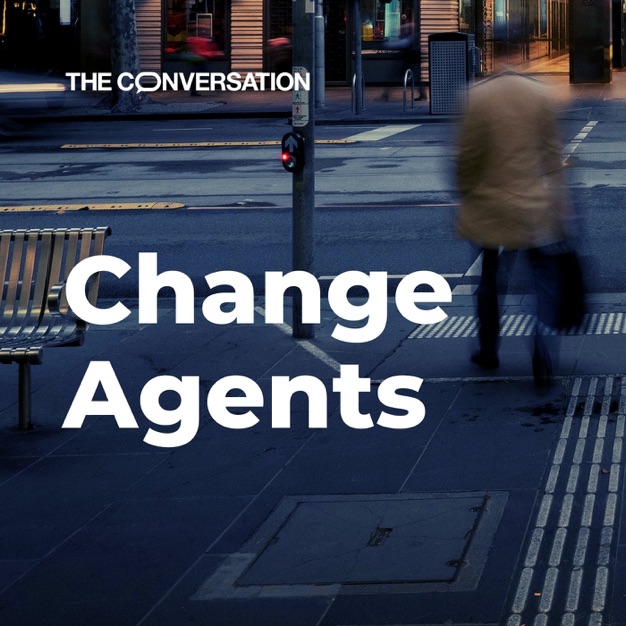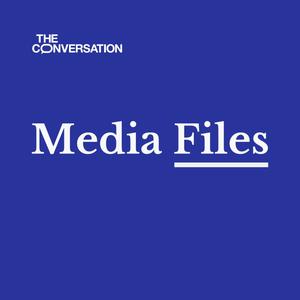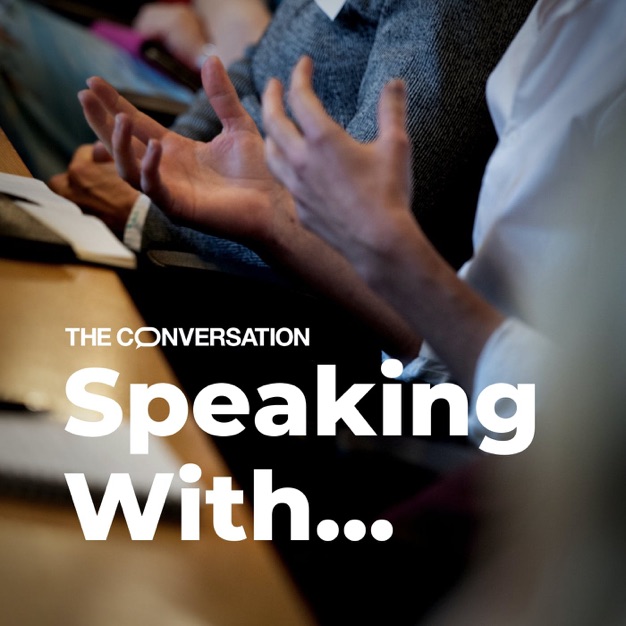
Essays On Air
The Conversation
Join us as we read aloud fascinating, meticulously researched essays penned by academics who are experts in their fields.
- 30 minutes 10 secondsNimbin before and after: local voices on how the 1973 Aquarius Festival changed a town forever
 A scene at the Aquarius Festival, Nimbin, 1973. Flickr/Harry Watson Smith, CC BY-SA
A scene at the Aquarius Festival, Nimbin, 1973. Flickr/Harry Watson Smith, CC BY-SAIn the north-east corner of Australia’s most populous state of New South Wales is a small former dairying and banana farming community. Today, however, that village is unrecognisable.
Nimbin is now widely acknowledged as Australia’s counter-cultural capital, a sister city to both Woodstock in New York State and Freetown Christiania in Denmark.
Among Nimbin’s tourist attractions today are its Hemp Embassy and the annual Mardi Grass festival in early May, which argues for the legislation of marijuana for personal and medicinal use.
The village’s transformation from a rural farming community to its present form can be traced to 1973, when Nimbin became the unlikely host of the Aquarius Festival – a counter-culture arts and music gathering presented by the radical Australian Union of Students.
 A scene from the Aquarius Festival in Nimbin, 1973.
Flickr/harryws20/Harry Watson Smith, CC BY
A scene from the Aquarius Festival in Nimbin, 1973.
Flickr/harryws20/Harry Watson Smith, CC BY
Why is Nimbin the way it is?
These social and political origins of the commodified hippie culture on display today in Nimbin have become less apparent to visitors and more recent migrants to the region.
Visitors, especially those arriving on bus tours, tend to shop, buy coffee and leave again. To counter this, the Nimbin Tourism Office commissioned me in 2016 to produce an app-based audio walk to promote a deeper engagement for tourists with the town and help answer the question: why is Nimbin the way it is?
Here’s a snippet:
Local voices on how the 1973 Aquarius Festival changed Nimbin forever. Jeanti St Clair, CC BY2.44 MB (download)The audio walk, an adapted version of which features on today’s episode of Essays On Air, was published onto the GPS-enabled mobile phone app Soundtrails. Soundtrails is owned by The Story Project, an Australian organisation focusing on oral history-based audio walks and they’ve published more than a dozen such walks in regional Australia.
 A scene from the Aquarius Festival in Nimbin, 1973.
Flickr/Harry Watson Smith/harryws20, CC BY
A scene from the Aquarius Festival in Nimbin, 1973.
Flickr/Harry Watson Smith/harryws20, CC BY
Anyone with a smartphone can access it by downloading the app and the Nimbin audio walk and following the route through the village’s streets and parklands. Headphones provide the best experience.
The stories I share with you today are excerpts from the Nimbin Soundtrail and are drawn from consultations and interviews with more than 60 Nimbin residents, Aquarius Festival participants and Indigenous elders.
Here, I’ve tried to reconnect the past and the present to make clear how Nimbin became the counter-cultural capital that it is. And the caveat is that many of the events in this documentary walk happened more than 40 years ago. I’ve recognised that memories have merged with other retellings that evolved over the years and the definitive truth is perhaps unavailable. Any version of Nimbin’s counter-culture will be an incomplete history.
The nine months it took me to gather these stories and make some sense of how they fitted together were rewarding.
And while there are some who might dispute the accounts of what happened in these stories, others agree that it’s a fair record of Nimbin contemporary history. The full Nimbin soundtrack can be heard by downloading the Soundtrails app and listening here. And if you are ever in the area, I invite you to take a day out, visit and listen to the stories in town.
 A crowd at the Nimbin Hotel during the Aquarius Festival, Nimbin, 1973.
Flickr/Harry Watson Smith, CC BY
A crowd at the Nimbin Hotel during the Aquarius Festival, Nimbin, 1973.
Flickr/Harry Watson Smith, CC BY
New to podcasts?
Podcasts are often best enjoyed using a podcast app. All iPhones come with the Apple Podcasts app already installed, or you may want to listen and subscribe on another app such as Pocket Casts (click here to listen to Essays On Air on Pocket Casts).
You can also hear us on PlayerFM or any of the apps below. Just pick a service from one of those listed below and click on the icon to find Essays On Air.
Additional audio
Recording and editing by Jeanti St Clair from Southern Cross University.
This podcast contains excerpts from the Nimbin Soundtrail, used with grateful permission from The Story Project/Soundtrails. See the app for the walk’s full credit list.
Selections of original music from the Nimbin Soundtrail by Neil Pike.
Excerpt from Deke Naptar’s Culture, Culture from Necroscopix (1970-1981), Free Music Archive
Fair Use Excerpts: Nimbin Mardi Grass 2018 parade ABC, Vietnam Lottery, 1965 Pathé Australians Against War 1966 ABC, This Day Tonight, anti-Vietnam War Moratoriam, 1970 Gough Whitlam policy speech, 1972 It’s Time, ALP campaign song, 1972
Snow by David Szesztay
Jeanti St Clair would like to again thank Lismore City Council and Nimbin Tourism for commissioning the Nimbin Soundtrail, and all the many contributors to the audio walk.
Additional reading/listening
Image
Lead image from Flickr/harryws20/Harry Watson Smith/, published under Creative Commons.
Correction: An earlier version of this article included a caption that described the 1973 Aquarius Festival as the “first”. In fact, it was the first Aquarius festival in Nimbin, and followed other Aquarius festivals that had taken place on university campuses.

Jeanti St Clair has consulted in the past for Soundtrails as an associate producer. She was paid by Lismore City Council to produce the audio walk. She does not have any ongoing financial benefit from Soundtrails or Lismore City Council.
3 May 2019, 2:11 am - 22 minutes 5 secondsEssays On Air: the politics of curry
 I had never encountered the word 'curry muncher' until I arrived in Australia 10 years ago. Shutterstock
I had never encountered the word 'curry muncher' until I arrived in Australia 10 years ago. ShutterstockOpening Night, Melbourne Comedy Festival 2018. Dilruk Jayasinha’s introductory salvo:
This is so exciting. I honestly… Sorry, it’s unbelievable — that I get to do stand-up comedy here at the Palais in Melbourne. Because I… I’m from Sri Lanka! And I used to be an accountant. Yeah. A Sri Lankan accountant!!! So — not just a money cruncher, but a curry-munching money cruncher!
Thaaat word … is it back again? For someone who has spent the last 30 years of her life specialising in English literary, postcolonial and cultural studies, I had never encountered it until I arrived in Australia 10 years ago.
On today’s episode of Essays On Air, a podcast from The Conversation, I’m reading my essay, titled The politics of curry.
Find and subscribe to Essays on Air in Apple Podcasts, Pocket Casts or wherever you get your podcasts.
Read more: When a suburb's turn for gentrification comes ...
Additional audio
Big Mojo Vadodara by Kevin MacLeod
Dilruk Jayasinha’s performance at the Melbourne Comedy Festival 2018 (used under fair dealing)
Indian beats by delta9THC #2
Indian dream by zebra 404
Old Man’s Tale by David Szesztay
Snow by David Szesztay
Sound effects from Orange Free Sounds and Free Sound
Today’s episode was recorded and edited by Maggy Liu.

Mridula Nath Chakraborty does not work for, consult, own shares in or receive funding from any company or organisation that would benefit from this article, and has disclosed no relevant affiliations beyond their academic appointment.
2 October 2018, 11:14 pm - 16 minutes 54 secondsEssays On Air: The female dwarf, disability, and beauty
 Detail from Little Big Woman: Condescension, Debra Keenahan, 2017. Designed and made by Debra Keenahan, Photograph by Robert Brindley., Author provided (No reuse), Author provided
Detail from Little Big Woman: Condescension, Debra Keenahan, 2017. Designed and made by Debra Keenahan, Photograph by Robert Brindley., Author provided (No reuse), Author providedFor centuries, women with dwarfism were depicted in art as comic or grotesque fairytale beings. But artists are challenging these portrayals and notions of beauty and physical difference.
Essays On Air, a podcast from The Conversation, brings you the best and most beautiful writing from Australian researchers.
Today, Western Sydney University researcher Debra Keenahan is reading her essay, titled The female dwarf, disability, and beauty.
Find us and subscribe in Apple Podcasts, in Pocket Casts or wherever you get your podcasts.
Additional audio
Snow by David Szesztay
Oboe Sonata in C minor “Farewell” by Dee Yan Key
Game of Thrones quote from HBO (used under fair dealing)
Sound effects from Orange Free Sounds and Free Sound
Today’s episode was recorded by Sunanda Creagh and edited by Jerwin De Guzman.
 6 August 2018, 6:25 am
6 August 2018, 6:25 am - 25 minutes 39 secondsEssays On Air: Australia’s property boom and bust cycle stretches back to colonial days
 In the 1980s, Australian geographer Maurice Daly exposed the urban planning system as a policy toolkit developers could capitalise on to drive subdivision and speculation – an insight that remains true even today. AAP Image/Lukas Coch
In the 1980s, Australian geographer Maurice Daly exposed the urban planning system as a policy toolkit developers could capitalise on to drive subdivision and speculation – an insight that remains true even today. AAP Image/Lukas CochAustralia’s property market is slowing and many people are contemplating a possible bust. But today’s episode of Essays On Air reminds us that even since colonial days, Australia’s property market has had its ups and downs.
Essays On Air, a podcast from The Conversation, brings you the best and most beautiful writing from Australian researchers.
Today, University of Sydney urbanism researchers Alistair Sisson and Dallas Rogers narrate a recent essay they wrote for the journal Australian Geographer on boom and bust cycles in major Australian cities.
It’s titled Property speculation, global capital, urban planning and financialisation: Sydney Boom, Sydney Bust redux. It was recorded and edited by Dallas Rogers and written with Alistair Sisson and Chris Gibson for the 100th anniversary of the journal Australian Geographer.
The audio version features the voices of Roderick Chambers and Kevin Suarez, producers from the community radio station 2SER.
The authors would like to acknowledge the Gadigal people of the Eora nation, upon whose land their research takes place.
Find us and subscribe in Apple Podcasts, in Pocket Casts or wherever you get your podcasts.
Additional audio
Strange Dog by Blue Dot Sessions
Atlantic State of Mind (A Long Winter) by McGee
Gnossienne No3 by Trans Alp
Soundscape audio sourced from freesound.org
Hip Horns With Drums by (none given)

Dallas Rogers recently received funding from The Henry Halloran Trust, Australian Housing and Urban Research Institute (AHURI), Urban Growth NSW, Landcom, University of Sydney, Western Sydney University, and Community Broadcasting Association of Australia (CBAA).
Alistair Sisson receives funding from an Australian Government Research Training Program Scholarship.
10 May 2018, 8:13 am - 16 minutes 51 secondsEssays On Air: how archaeology helped save the Franklin River
 The battle for the Franklin River runs far deeper than simply providing the backdrop for a political tug-of-war. PETER DOMBROVSKIS/ LIZ DOMBROVSKIS/AAP
The battle for the Franklin River runs far deeper than simply providing the backdrop for a political tug-of-war. PETER DOMBROVSKIS/ LIZ DOMBROVSKIS/AAPOn 1 July 1983, in a dramatic four-three decision, the High Court of Australia ruled to stop the damming of the Franklin River. It ended a long campaign that helped bring down two state premiers and a prime minister, as well as overseeing the rise of a new figure on the political landscape – the future founder of the Greens, Bob Brown.
But the battle for the Franklin River runs far deeper than simply providing the backdrop for a political tug-of-war.
In today’s episode of Essays on Air - the audio version of The Conversation’s Friday essay series - writer and historian Billy Griffiths reads his essay on how archaeology helped save the Franklin River. Its rich history and significance to the Tasmanian Aboriginal community made the proposed dam a controversy that captivated the nation.
Today’s episode was recorded and edited by Sybilla Gross. Find us and subscribe in Apple Podcasts, in Pocket Casts or wherever you get your podcasts.
Additional Audio
Snow by David Szesztay
Cave Drips by everythingsounds
Climbing gear by Benboncan
Cave footsteps by Timbre
Cave River by jpdeglet69
Pottery sounds by Tumbleweed3288
Loud River by FractalStudios
Panting by Drkvixn91
Fire crackling by daenerys
Rain by acclivity
Howling Wind by DBlover
Newspaper by deleted_user_1116756
Parliament sounds by AusQuestionTime
Protest by dnlburnett
Rally clap by mw_1984
Correction: An earlier version of this story featured the wrong picture as its lead image. The error was made in the production process. The Conversation apologises for the mistake, and thanks readers who brought it to our attention.

Billy Griffiths does not work for, consult, own shares in or receive funding from any company or organisation that would benefit from this article, and has disclosed no relevant affiliations beyond their academic appointment.
3 May 2018, 11:44 pm - 19 minutes 32 secondsEssays On Air: can art really make a difference?
Ben Quilty, Life vest, Lesbos. 2016, oil on polyester, 60 x 50cm Australian War Memorial
Before the early 19th century, war was commonly depicted as a heroic venture, while death was both noble and surprisingly bloodless. Then came Goya with his collection of etchings called Disasters of War to show the full horror of what Napoleon inflicted on Spain, during the Peninsular War from 1808 to 1814. The art showed, for the first time, the suffering of individuals in the face of military power.
On today’s episode of Essays on Air - the audio version of The Conversation’s Friday essay series - Conversation intern Sybilla Gross is reading my essay on the transformational power of art in our collective social conscience.
Through countless wars and humanitarian crises, art has always depicted the crimes of our times.
Putting aside whether or not art can actually change the world, there is always an important message it conveys - should we choose to listen. Maybe, that is all we can ask of it.
Today’s episode was recorded and edited by Sybilla Gross. Find us and subscribe in Apple Podcasts, in Pocket Casts or wherever you get your podcasts.
Additional Audio
I Am a Man Who Will Fight for your Honor by Chris Zabriskie
Unfoldment, Revealment, Evolution, Exposition, Integration, Arson by Chris Zabriskie
Hibernation by Sergey Cheremisinov
The Answer by British Council (film)
Arctic Shooting Training by qubodup
Explosion by Omar Alvadaro
Moans and Screams by qubodup
Chaos and Screams (2013) by Iwan Gabovitch
Modern Day War by Omar Alvarado
Last Post by Benboncan link text
Life in the 30s - McGraw Hill Films
Small clap by kellieskitchen
Crowd waiting Menin Gate 2016 by Stitlown
Gasp 4 by jayfrosting
Cicadas/wind by dobride
Riots (Leipzig) by pillonoise
Screaming Crowd by magician5
Waves crashing by Ali_6868
Female sobbing by Idalize
Burning Air by sergeeo
Human Flow (Trailer) - Amazon Studios, Participant Media and AC Films
Street noise by smellor123
Sitar and Tabla Duo by Bruce Miller

Joanna Mendelssohn has received funding from the Australian Research Council for Design and Art of Australia on Line and for a Linkage Project on exhibitions of Australian art.
19 April 2018, 8:05 pm - 17 minutes 21 secondsEssays On Air: Monsters in my closet – how a geographer began mining myths
 The Loch Ness Monster and other folk tales might not be pure fiction, but actually based on memories of events our ancestors once observed. Shutterstock
The Loch Ness Monster and other folk tales might not be pure fiction, but actually based on memories of events our ancestors once observed. ShutterstockSo you think the Loch Ness Monster never existed? Think again.
The science of “geomythology” is breathing new life into such stories. The Loch Ness Monster and other folk tales might not be pure fiction, but actually based on memories of events our ancestors once observed.
On today’s episode of Essays On Air, the audio version of The Conversation’s Friday essay series, I’m reading my essay on the geographical truths behind some of humankind’s most mysterious myths.
Traditional stories about age-old events might actually reveal clues about the geological history of the Pacific.
Through research of ancient oral knowledge, we have opened up opportunities for understanding the minds of our ancestors, more than we ever thought possible.
Today’s episode was recorded by Michael Lund and edited by Sybilla Gross. Find us and subscribe in Apple Podcasts, in Pocket Casts or wherever you get your podcasts.
Additional Audio
Snow by David Szesztay
Scenery by Kai Engel
Brand New World by Kai Engel
August (Summer Nights) by Kai Engel
Lake waves by Benconcan
Rumble by Unfa
Cinematic deep rumble by Mmasonghi
Low rumble by Tec studios
‘Monster’ rumble by Ecfike
Chanting (scary) by theartisticfellow
Thunder by Justkiddink
Single wave breaks by Dobroide
Explosion by tommccann
Hawaii volcanoes by e__
Fiji Island Singing by Joseph Galea
College campus ambience by Relebogile
Fiji Coup Latest: Journalists by AP Archive
Fiji: Ethnic Indians Flee the Unrest by AP Archive
Boots marching by stib
Military sounds by qubodup
Pages turning by zamazan
Pottery sounds by Tumbleweed3288
Didgeridoo by sandyrb
Native American style flute in A by Wood_Flutes
Hissing gas by Taberius
Library by artemis_ch
Celtic tin whistle by luis_audp

Patrick D. Nunn receives funding from the Australian Research Council, the Asia-Pacific Network for Global Change Research, Région Pays de la Loire (France), the University of the Sunshine Coast, and the Social Science and Humanities Research Council of Canada.
29 March 2018, 1:05 am - 16 minutes 4 secondsEssays On Air: Joan of Arc, our one true superhero
 Why did this woman, so devoted to her political cause and to her vision of a united France, chose to be burnt at the stake at the age of 19 instead of acquiescing to her judges’ directives? shutterstock.com
Why did this woman, so devoted to her political cause and to her vision of a united France, chose to be burnt at the stake at the age of 19 instead of acquiescing to her judges’ directives? shutterstock.comOne need not be a parent of a young child, as I am, to be conscious of the full-blown resurgence of the superhero in contemporary popular culture. But there is more to a hero than courage and strength.
On today’s episode of Essays On Air, the audio version of The Conversation’s Friday essay series, I’m reading my essay on Joan of Arc, our one true superhero.
She’s been depicted as a national heroine and a nationalist symbol (and also, to my and many a leftists’ dismay, a popular mascot by French ultra-nationalists), a rebellious heretic and a goodly saint. A feminist role model and a belligerent military leader, an innocent mystic and a tortured victim.
However one may choose to view her, there can be no denying that she is, and will continue to be, one of the most singular and significant exemplars of our troubled species. Forget Wonder Woman and Batman – Jeanne d’Arc may be our one and only true superhero.
Today’s episode was edited by Sybilla Gross. Find us and subscribe in Apple Podcasts, in Pocket Casts or wherever you get your podcasts.
Additional Audio
Snow by David Szesztay
Choral Music by dobroide
Outdoor farming sounds by klankbeeld
Superhero flash by oscaraudiogeek
I am Batman! And you are Dust! - Warner Brothers
Fantasy Orchestra by bigmanjoe
Horse Battle Sounds by Joao_de_Dues
Four Voices Whispering by geoneo0
Female battle cries by 11linda
Book shop interior by mzui
Pages turning by Zamazan
Ofelia’s Dream by Bensound
Battle Horn 1 by kirmm
Victory Cry by chripei
Rainy Day by Dee Yan-Key
Piano Movement by Bensound
Jeanne d’Arc by Gaumont

Ali Alizadeh does not work for, consult, own shares in or receive funding from any company or organisation that would benefit from this article, and has disclosed no relevant affiliations beyond their academic appointment.
8 March 2018, 5:42 am - 16 minutes 11 secondsEssays On Air: The personal is now commercial – beauty, fashion and feminism
 Eva Blue/Flickr, Southern Cross Austereo, CC BY-SA
Eva Blue/Flickr, Southern Cross Austereo, CC BY-SASecond wave feminists protested against women’s magazines and beauty pageants. Today, however, beauty and fashion editors such as Elaine Welteroth (recently of Teen Vogue) are some of the most high profile voices of a resurgent feminist movement.
On my most Pollyannaish days, I want to cheer online publications that mix politics with fashion and beauty for the way they are mainstreaming feminism. On closer inspection, though, this lashing together of feminist politics with a women’s magazine sensibility has produced some odd results.
In today’s episode of Essays On Air - the audio version of The Conversation’s Friday essay series - I’m reading an edited version of my recent essay, The personal is now commercial – popular feminism online.
With the #metoo movement bringing feminism right to the centre of mainstream debate, it’s time to take a closer at how popular feminism plays out online.
Find us and subscribe in Apple Podcasts, in Pocket Casts or wherever you get your podcasts.
Today’s episode was edited by Jenni Henderson.
Additional audio
Snow by David Szesztay
Walter’s Wonderland by Matt Oakley
Ms. America, Up Against the Wall by Maisonpop93
Elaine Welteroth (teen vogue editor) on The Real Daytime
Australia: Thousands march for equal rights in Melbourne on Women’s Day by Ruptly
Ask Mia - Anxiety by MamaMia
Women’s March on Washington: Full Rally by The New York Times
80s Interlude by Fanas
Tomb Raider (club mix) by Music For Your Plants

Kath Kenny does not work for, consult, own shares in or receive funding from any company or organisation that would benefit from this article, and has disclosed no relevant affiliations beyond their academic appointment.
1 March 2018, 7:20 am - 23 minutes 7 secondsEssays On Air: On the Sydney Mardi Gras march of 1978
 Marchers at the 1978 Mardi Gras parade. Sally Colechin/The Pride History Group, Author provided
Marchers at the 1978 Mardi Gras parade. Sally Colechin/The Pride History Group, Author providedOn a cold Saturday night in Sydney on June 24, 1978, a number of gay men, lesbians and transgender people marched into the pages of Australian social history. I was one of them.
On today’s episode of Essays On Air, the audio version of The Conversation’s Friday essay series, Conversation editor Lucinda Beaman is reading my essay on the Sydney Mardi Gras march of 1978.
On the eve of the 40th anniversary of the Sydney Gay and Lesbian Mardi Gras, it’s worth revisiting the events of that night and reflecting on the remarkable lesson that, for oppressed minorities, there comes a time when enough is enough.
Much has been achieved, but it would be a major mistake to relax and assume that history is progressively improving.
Join us as we read to you here at Essays On Air, a podcast from The Conversation.
Find us and subscribe in Apple Podcasts, in Pocket Casts or wherever you get your podcasts.
Today’s episode was edited by Sybilla Gross.
Additional audio
Snow by David Szesztay
Tom Robinson, Glad to be gay.
Mavis Staples, We shall not be moved
Podington Bear, Memory Wind, from Free Music Archive
David Szesztay, Flash, from Free Music Archive
David Szesztay, Looking Back, from Free Music Archive

Mark Gillespie is affiliated with The '78ers
22 February 2018, 6:39 am - 12 minutes 3 secondsEssays On Air: When did Australia’s human history begin?
 In July 2017, new research was published that pushed the opening chapters of Australian history back to 65,000 years ago. Marcella Cheng/The Conversation, CC BY-NC-ND
In July 2017, new research was published that pushed the opening chapters of Australian history back to 65,000 years ago. Marcella Cheng/The Conversation, CC BY-NC-NDIn July 2017, new research was published that pushed the opening chapters of Australian history back to 65,000 years ago. It is the latest development in a time revolution that has gripped the nation over the past half century.
In today’s episode of Essays On Air - the audio version of our Friday essay series - we’re reading you Billy Griffiths, Lynette Russell and Richard “Bert” Roberts’ essay When did Australia’s human history begin?
This essay seeks to move beyond the view of ancient Australia as a timeless and traditional foundation story to explore the ways in which scientists and humanists are engaging with the deep past.
Find Essays On Air in Apple Podcasts, in Pocket Casts or wherever you get your podcasts.
Additional audio
Snow by David Szesztay
Tourism Australia advertisement
Didgeridoo by Jimmie P Rodgers
I am Australian by The Seekers
This episode was edited by Jenni Henderson. Illustration by Marcella Cheng.
 15 February 2018, 5:56 pm
15 February 2018, 5:56 pm - More Episodes? Get the App
Your feedback is valuable to us. Should you encounter any bugs, glitches, lack of functionality or other problems, please email us on [email protected] or join Moon.FM Telegram Group where you can talk directly to the dev team who are happy to answer any queries.





 Business Briefing
Business Briefing
 Change Agents
Change Agents
 Trust Me, I'm An Expert
Trust Me, I'm An Expert
 In Depth, Out Loud
In Depth, Out Loud
 Media Files
Media Files
 Speaking with...
Speaking with...